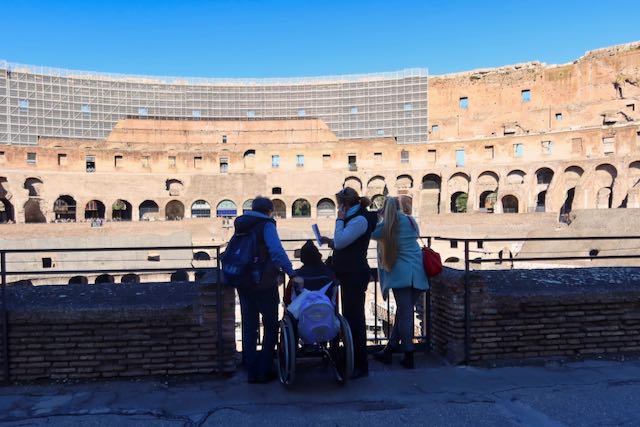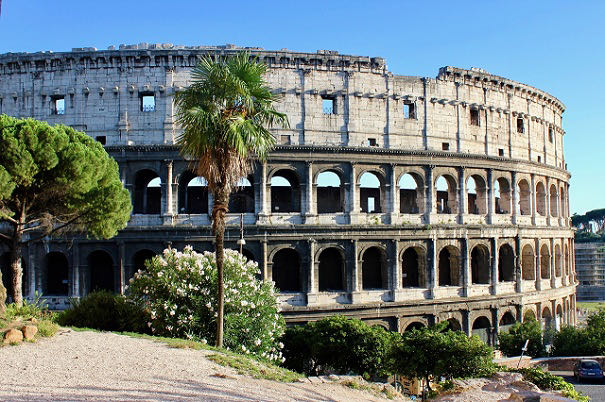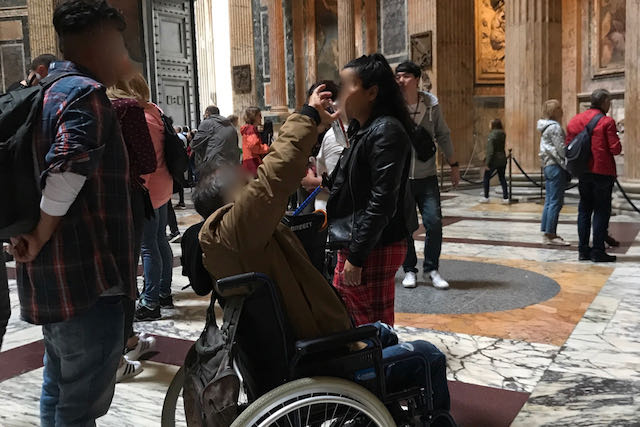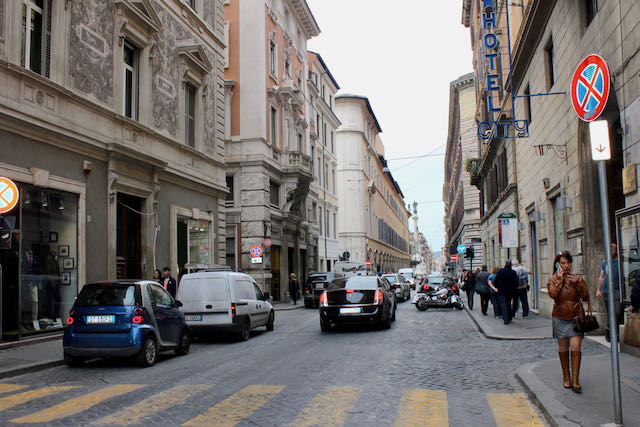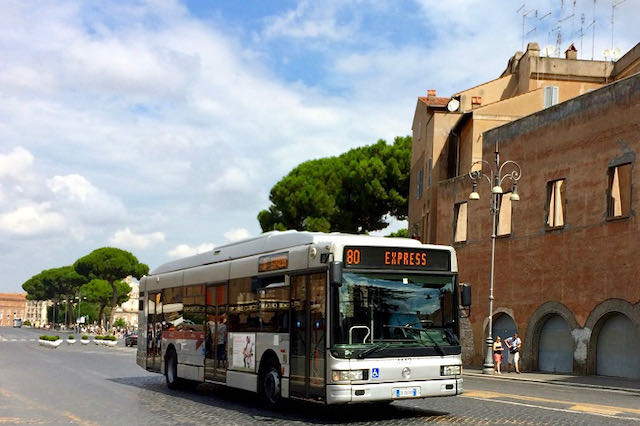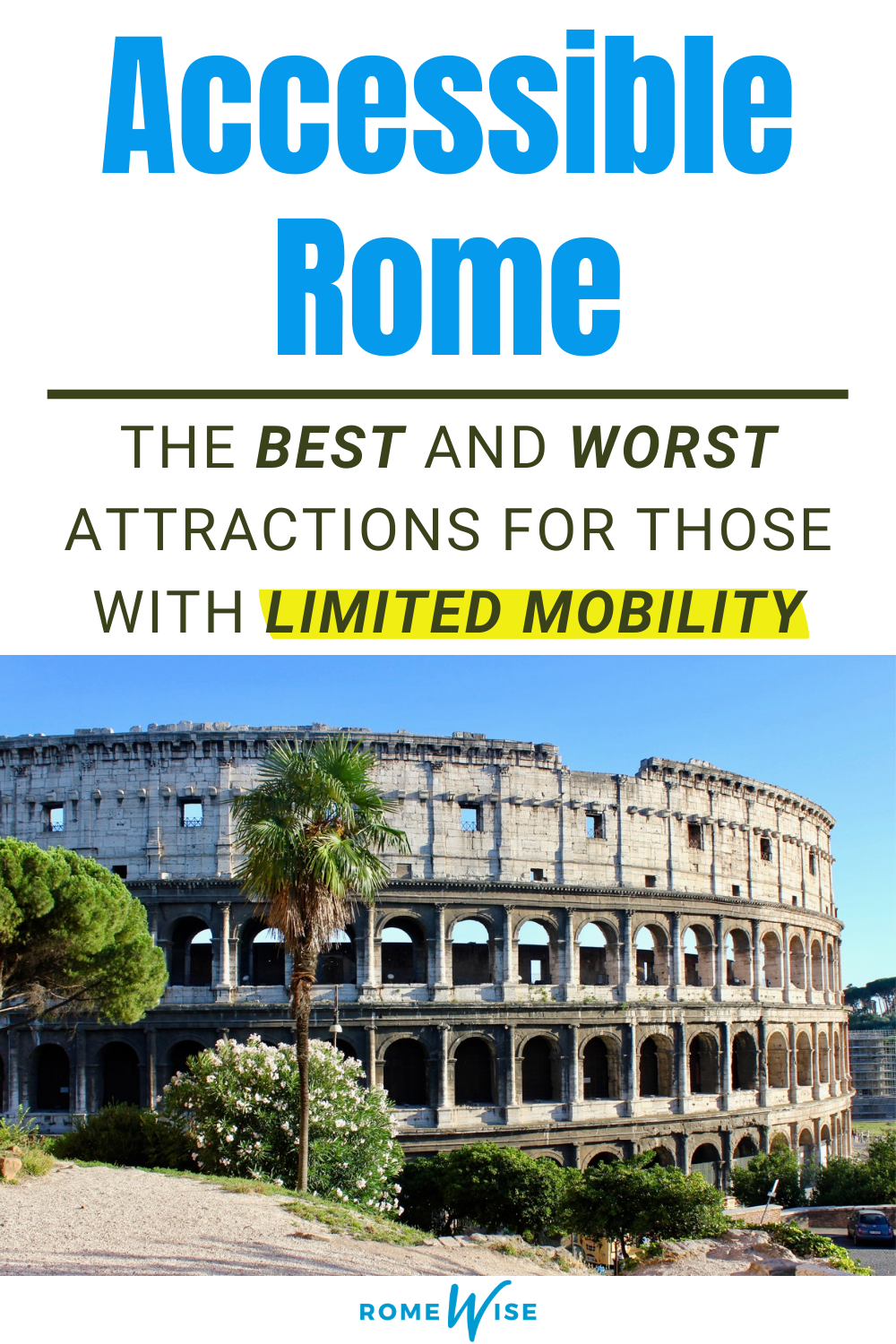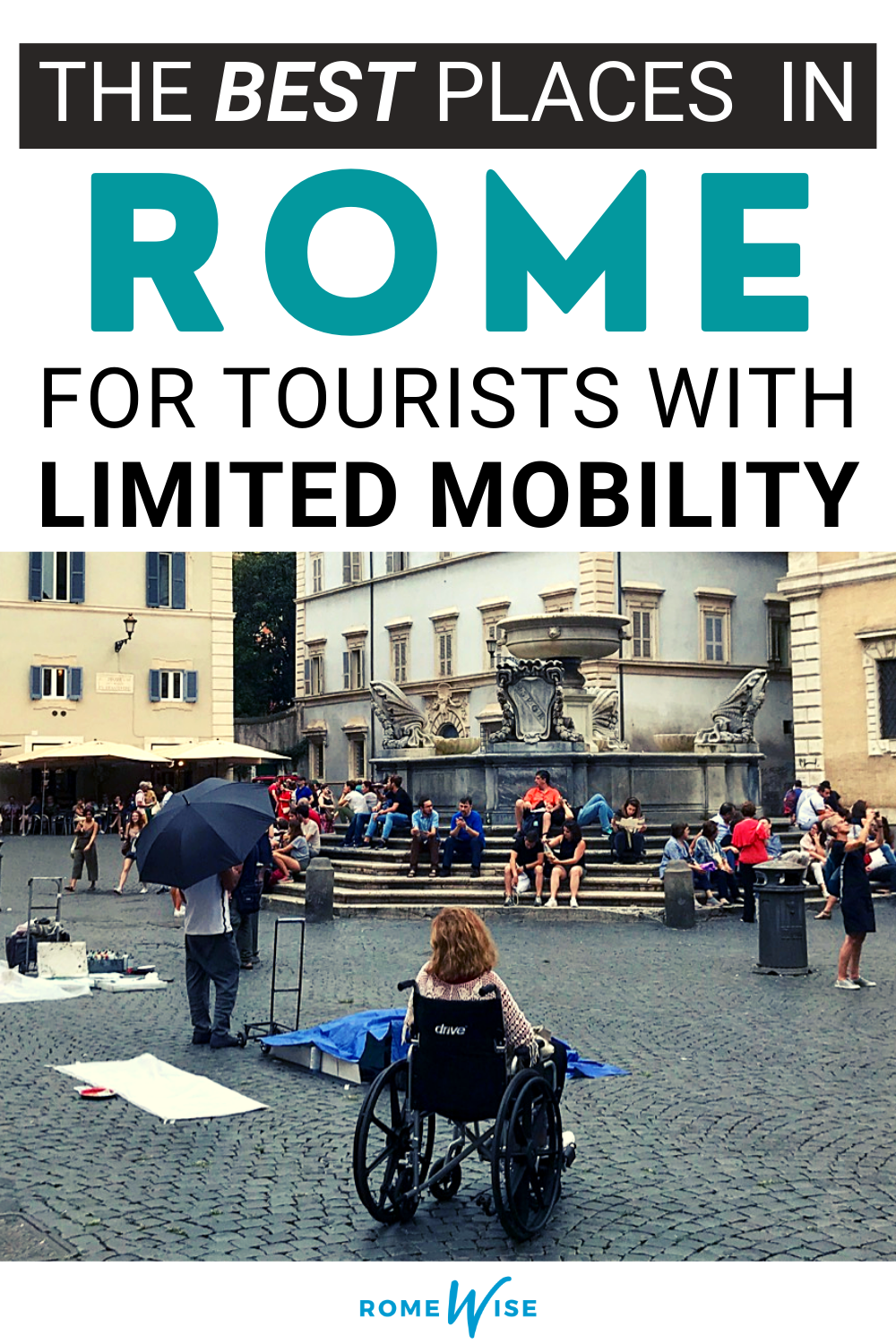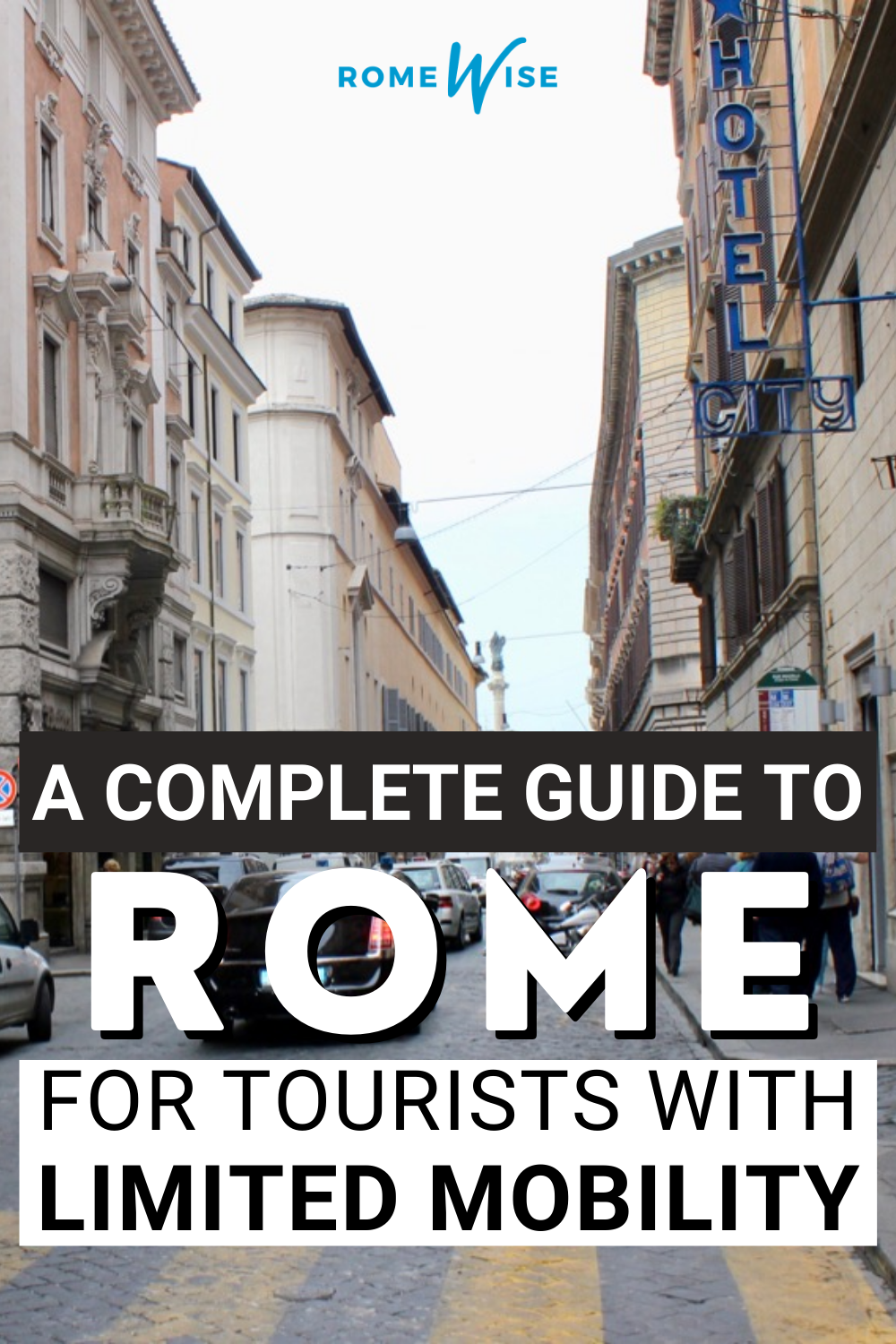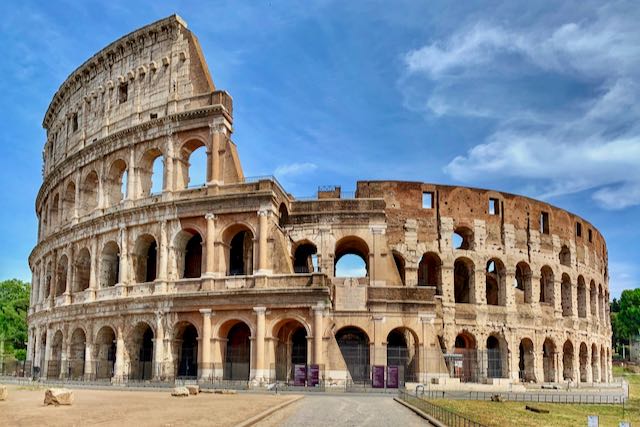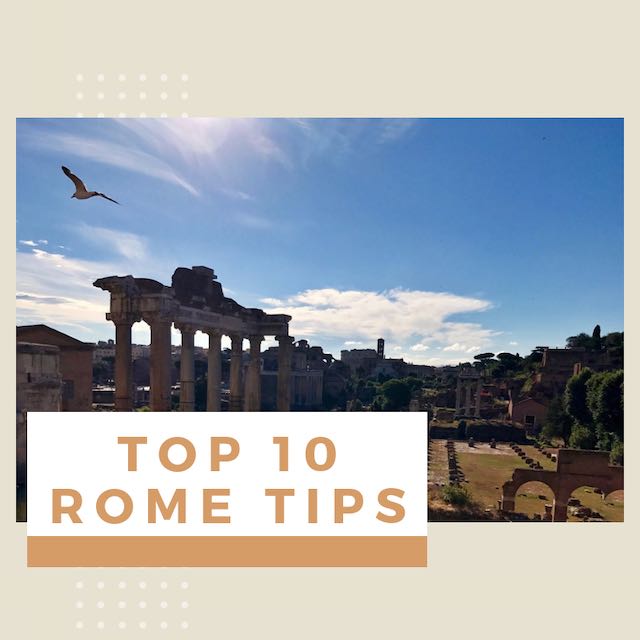- Sign up & get a FREE ebook Subscribe NOW!
- Romewise Home Page
- What to Do in Rome
- Accessible Rome
Accessible Rome - Top Tips For Visiting With Limited Mobility
Looking for accessible Rome tips?
Rome streets and sidewalks can be notoriously difficult to navigate as a pedestrian, let alone in a wheelchair or with a walking stick.
However, there are plenty of options for people with limited mobility to visit Rome's attractions.
Wheelchair Accessible Rome and Other Options for Visiting Rome with Limited Mobility
I usually recommend walking around Rome, so you can go slowly and see smaller streets and piazzas.
Of course, this is not always feasible.
If you have limited mobility, there are still lots of way to enjoy Rome.
Here's what you need to know about visiting Rome with limited mobility or in a wheelchair:
- Which Rome sites are most accessible?
- What are some good tours that cater to people in wheelchairs?
- What are some less accessible Rome sites?
- Where can you rent a wheelchair in Rome?
- What are some hotels that have good facilities for people with disabilities?
- What are the best ways to get around Rome if you are in a wheelchair or have a walking disability?
Sight-seeing in Rome in a Wheelchair
The ancient Romans were pretty amazing at building aqueducts, roads, and monuments that have stood for centuries.
Unfortunately, it seems that modern Rome has not quite come up to 20th century standards when it comes to accessibility.
We have a lot of uneven cobblestone streets (that already make walking hard on one's feet), broken curbs, and either non-existing sidewalks or sidewalks so narrow, you need to walk in single file.
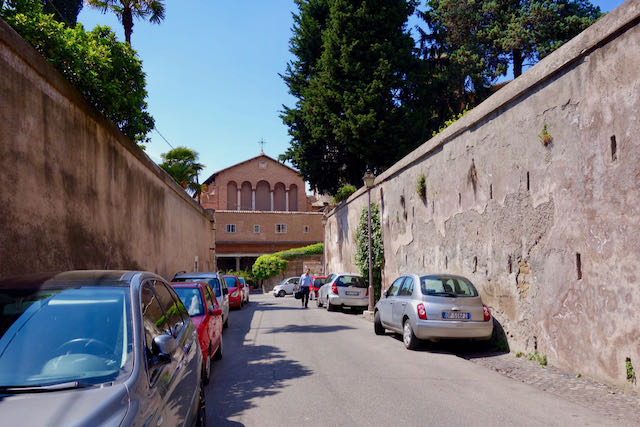 On this Roman street, there is no sidewalk, and what little side-space there is, has been taken up by cars parked illegally.
On this Roman street, there is no sidewalk, and what little side-space there is, has been taken up by cars parked illegally.These are barely ideal conditions for walking, let alone getting around on wheels, whether we are talking about a wheelchair, bicycle, or baby stroller.
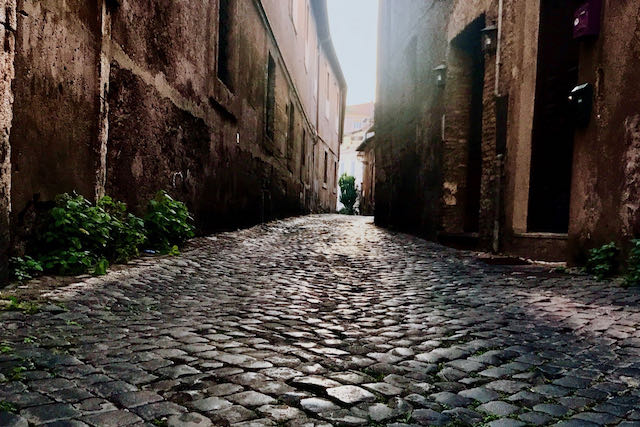 On this typical Trastevere street, you can see the types of cobblestones we have in a lot of places around Rome - charming but uncomfortable, and sometimes, difficult to manage.
On this typical Trastevere street, you can see the types of cobblestones we have in a lot of places around Rome - charming but uncomfortable, and sometimes, difficult to manage.Accessible Rome Sites
Most of Rome's popular attractions have at least some accessibility for people with limited mobility or in a wheelchair.
The Vatican and Sistine Chapel
The Vatican Museums has a really excellent page in English with everything you need to know about visiting the Vatican Museums with limited mobility.
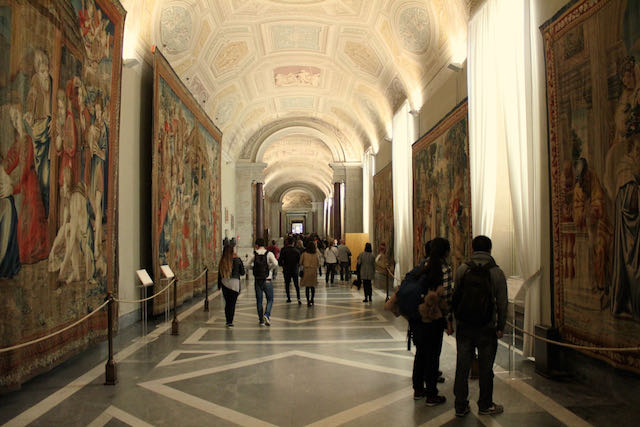 Visiting the Vatican in a wheelchair is very doable. You may miss parts of the normal itinerary but of course you will see the Sistine Chapel.
Visiting the Vatican in a wheelchair is very doable. You may miss parts of the normal itinerary but of course you will see the Sistine Chapel.Entrance is free to those in a wheelchair as well as their caregiver.
You can come with your own wheelchair or ask to use one of theirs (free.)
They have several available to borrow but if you want to be absolutely sure you get one when you go, you can write them in advance at accoglienza.musei@scv.va.
One great thing is you do not have to worry about booking in advance.
Just show up and you will be shown where to go to collect your free ticket.
If you have a disability but are not in a wheelchair, visit the Vatican Museums website to see if you are eligible for free entry.
You can also visit Saint Peter's Basilica with a wheelchair.
There are plenty of ramps throughout that make it fairly easy.
All the bathrooms have at least one stall for those in a wheelchair.
I've found the best online advice about this is on John Sage's website.
 You can visit Saint Peter's basilica in a wheelchair. You can skip the security line, and go up a special ramp for wheelchairs.
You can visit Saint Peter's basilica in a wheelchair. You can skip the security line, and go up a special ramp for wheelchairs.One thing that is unfortunately not available to those who are in a wheelchair and unable to walk at all is the shortcut that goes from the Sistine Chapel to Saint Peter's Basilica.
Part of this shortcut does involve a small ramp but most of it is made up of stairs and there is no lift or other equipment that would enable someone in a wheelchair to take this shortcut.
🤙 Roaming in Rome? 📱
Get yourself an Italian eSIM for calls, messages and data when traveling here.
Save on data charges with plans from just 19€ from Holafly - our recommended eSIM provider - click here to find out more.
Colosseum, Roman Forum, and Palatine Hill
The Colosseum is certainly visitable in a wheelchair, but your options are a little limited.
There is a ramp for entry, and you can move around parts of the lower level of the Colosseum.
There is an elevator to reach the second level.
Unfortunately, it's not possible to visit the underground or upper tiers in a wheelchair.
Visit the Colosseum official website for details.
The perfect 3-day itinerary in Rome
Trying to figure out how to organize your visit to Rome? I've got the perfect 3-day itinerary for first-time visitors (or those who have not been here in a while.) It works for a 2.5 day visit as well.
In my 3-day itinerary, you'll see all the major must-see Rome attractions like the Vatican, Colosseum, Trevi Fountain, Pantheon, Piazza Navona, Spanish Steps, Castel Sant'Angelo, and much more.
And if you have more time, or want suggestions for extra/other things to do, you'll find that there too.
Visit my page with the best 3-day itinerary in Rome for first-timers.
Pantheon
Luckily it's pretty easy to visit the Pantheon in a wheelchair.
The square is paved with cobblestones but they are fairly uniform and the ground is mostly flat.
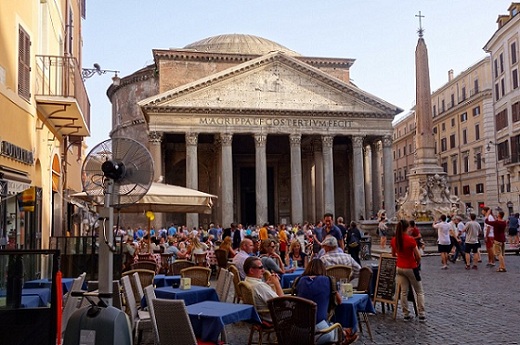 Although things are gradually changing, the Pantheon remains something of an obstacle course for travelers with a disability
Although things are gradually changing, the Pantheon remains something of an obstacle course for travelers with a disabilityInside the Pantheon, you can easily navigate those original marble floors put there during the reign of the Emperor Hadrian in around 120 C.E.
Galleria Borghese
You can visit the Galleria Borghese in a wheelchair.
You can come in your own, or ask to borrow one of theirs once you arrive.
You cannot book one of their wheelchairs in advance, but just ask when you get there.
 Visiting the Galleria Borghese in a wheelchair is very doable, and you can see both floors and all the rooms.
Visiting the Galleria Borghese in a wheelchair is very doable, and you can see both floors and all the rooms.There is an elevator inside that will allow you to visit both floors of this amazing museum.
This page is all about the accessibility of the Galleria Borghese.
Capitoline Museums
The Capitoline Museums is one of the more accessible Rome attractions.
You can visit much of the museum in a wheelchair.
I discovered, thanks to wheelchairtraveling.com, that the issue is more about GETTING TO the entrance to the Capitoline Museums.
 Luckily wheelchair access isn’t a problem at any of the main rooms of Capitoline Museums
Luckily wheelchair access isn’t a problem at any of the main rooms of Capitoline MuseumsTheir website shows how to access the museums.
But to get up the hill, you will need someone pretty strong and capable to push you up along the winding ramp on the side, or, you will need to take a taxi up there.
No matter what season you visit Rome, here are 4 essential things we recommend never leaving home without:
Disclosure: If you make a purchase through a link on this page, I may receive a small commission - at no extra cost to you. Thank you for supporting my site!
Largo di Torre Argentina
In June 2023, Rome opened the fascinating site of Largo di Torre Argentina to visitors.
You can now go down into this important archaeological space and get up close to the ancient temples there.
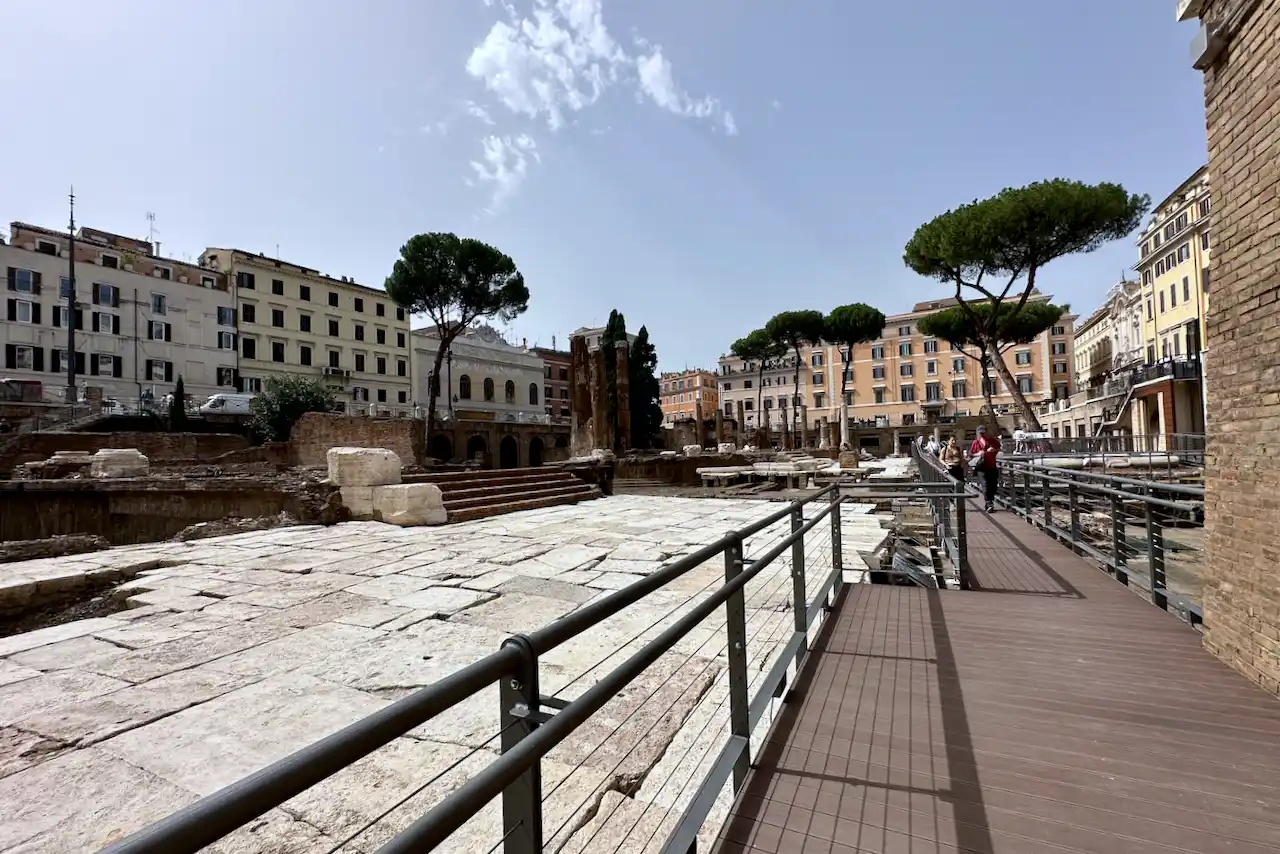 The wide flat walkways and lift at Largo di Torre Argentina make this an ideal site to visit for anyone in a wheelchair.
The wide flat walkways and lift at Largo di Torre Argentina make this an ideal site to visit for anyone in a wheelchair.The site is equipped with a lift as well as wide, well-built ramps and walkways, so is an excellent choice for visitors in a wheelchair.
Piazzas in Rome
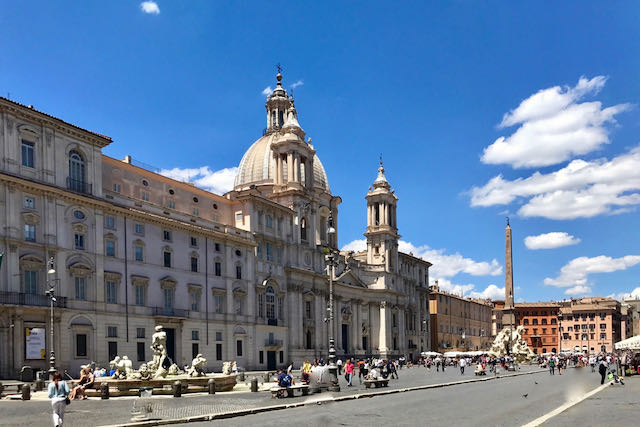 Piazza Navona with its Baroque fountains offers so much to do and is completely accessible for wheelchair users.
Piazza Navona with its Baroque fountains offers so much to do and is completely accessible for wheelchair users.Large piazzas like Piazza Navona, Piazza della Rotonda (where the Pantheon is), and Piazza del Popolo are also fairly easy to navigate in a wheelchair.
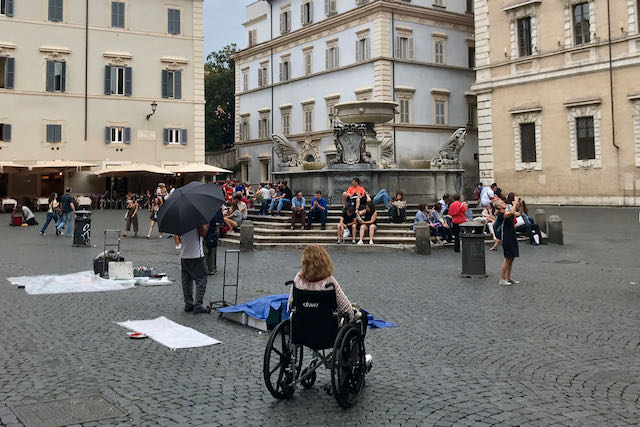 Santa Maria in Trastevere is a large, fairly flat piazza that is pretty easy to get around in a wheelchair.
Santa Maria in Trastevere is a large, fairly flat piazza that is pretty easy to get around in a wheelchair.Ready to plan your trip?
Book your train
Planning to travel between cities in Italy and other parts of Europe?
Use Trainline to see all the different options available across the different rail companies.
Find your hotel
Find your perfect place to stay in Rome.
Use Booking.com to choose between hotels, guesthouses, and self-catering apartments in neighborhoods throughout the Eternal City.
Buy your TurboPass
Purchase the convenient Turbopass and visit all of Rome's top attractions including the Colosseum, Pantheon, and Vatican.
With one handy pass, it's all included.
Less Accessible Rome Sites
While there are a few less accessible Rome sites for those in a wheelchair, you can still see a lot of Rome.
Below are some not-so accessible Rome places you might want to either skip, or visit with a tour company that specializes in tours of these areas.
Palatine Hill
The Palatine Hill is pretty difficult to manage in a wheelchair.
Below you can see the sign for a ramp for wheelchairs.
But most of the rest of Palatine Hill is made up of stairs, and bumpy dirt and stone roads, with lots of broken tiles.
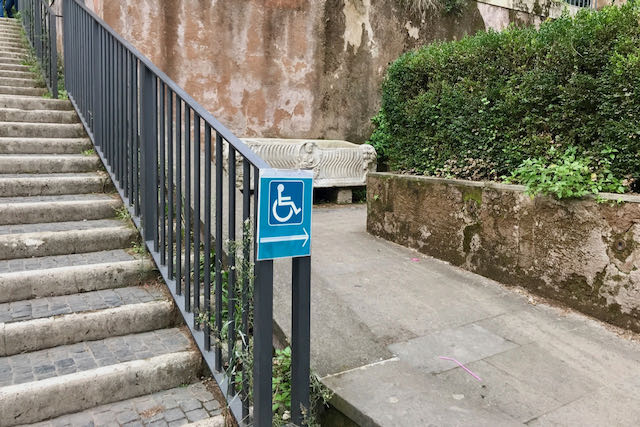 The founding fathers of Rome chose this hill to found the city. The terrain varies throughout its slopes. Nonetheless many amazing areas are accessible with wheelchair.
The founding fathers of Rome chose this hill to found the city. The terrain varies throughout its slopes. Nonetheless many amazing areas are accessible with wheelchair.There are a few places with ramps, but to see the best the Palatine Hill has to offer if you are in a wheelchair, you will need to be a little adventurous and intrepid.
However, I discovered this company called Rome and Italy Tours.
They have developed this amazing portable chair, which they call a "Wheely Trekky", and they can take you to the Palatine Hill and other similar less accessible Rome sites (see below for my suggestions for tour companies that specialize in accessible tours).
Trevi Fountain
On one hand, it may seem that visiting the Trevi Fountain in a wheelchair is not that difficult.
On the other, you have two factors that do in fact make it a bit hard to manage.
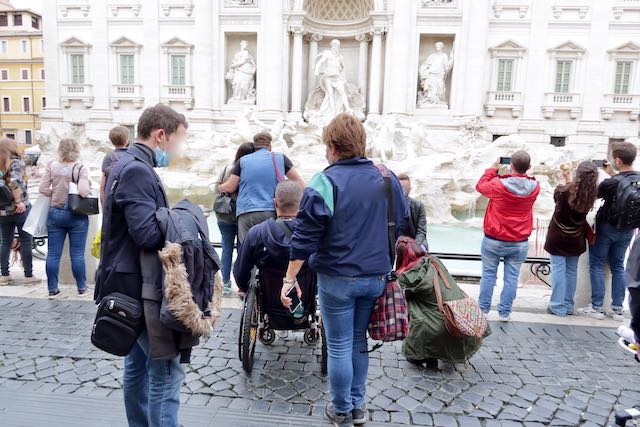 Yes you can visit Trevi Fountain if you are in a wheelchair. But it can be a bit difficult, especially when it's crowded.
Yes you can visit Trevi Fountain if you are in a wheelchair. But it can be a bit difficult, especially when it's crowded.The first is the small space that the Trevi Fountain is in.
The fountain seems outsized compared to the minimal space available for people to gather to look at the fountain.
And this means it's almost always crowded (except in the dead of winter, or between the hours of 2am-6am).
And the crowds definitely make it a pain to try to jostle for a spot in a wheelchair.
 The Trevi Fountain is beautiful but it's also often very crowded. You often need to jostle and push for a spot. Not an ideal way to see it if you are in a wheelchair.
The Trevi Fountain is beautiful but it's also often very crowded. You often need to jostle and push for a spot. Not an ideal way to see it if you are in a wheelchair.The second factor making it hard to see the Trevi Fountain is the stairs.
It doesn't mean you cannot see the Trevi Fountain in a wheelchair.
This just means that you may not be able to get down and close to the basin.
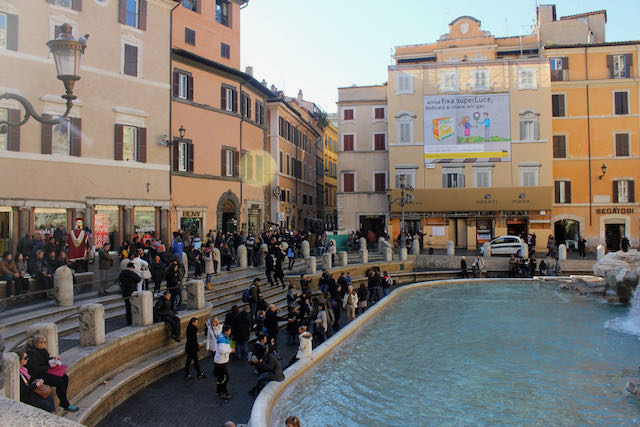 If you are in a wheelchair, you may not be able to get a closeup of the Trevi Fountain from the basin at the bottom.
If you are in a wheelchair, you may not be able to get a closeup of the Trevi Fountain from the basin at the bottom.My suggestion is to try to come early in the morning, or in low season, when there are fewer people.
 Dawn is in my opinion the best time to see the Trevi Fountain. This is also true if you are visiting Rome in a wheelchair. No crowds, no pushing.
Dawn is in my opinion the best time to see the Trevi Fountain. This is also true if you are visiting Rome in a wheelchair. No crowds, no pushing.Castel Sant'Angelo
Most of a visit to Castel Sant'Angelo involves walking up and around the building itself.
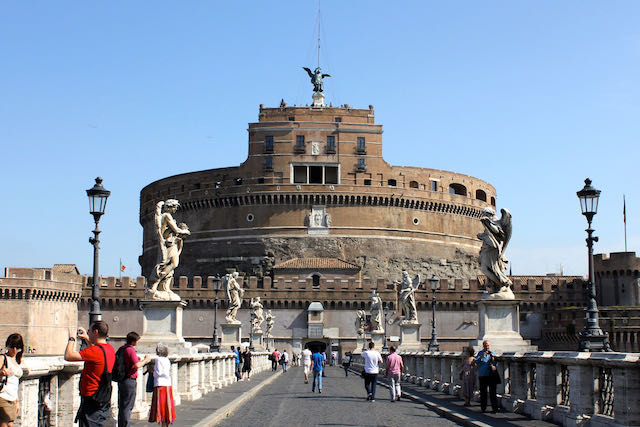 Rome's cultural institutions are not fully committed to accessibility. At Castel Sant’Angelo visitors in wheelchairs are welcome to use an elevator to go all the way to the top
Rome's cultural institutions are not fully committed to accessibility. At Castel Sant’Angelo visitors in wheelchairs are welcome to use an elevator to go all the way to the topThere is an elevator to take visitors to the top, but you miss most of the best of what the museum has to offer.
It's possible to visit this monument in a wheelchair, but your options will be unfortunately limited.
Accessible Rome Tours
You can book wheelchair accessible tours directly through the Colosseum website or the Vatican Museums website.
But if you want a more hands-on approach, and a tour specifically tailored to your disability, I have found that it's best to go through an agency that specializes in these types of tours.
Here are a few agencies that offer dedicated accessible tours in Rome:
- Sage Travelling bill themselves at the "European Disabled Travel Experts", and they have great, detailed information about visiting Rome and other parts of Italy and Europe. They also offer specific tours in Rome, based on your needs. You can contact them directly via their website.
- Accessible Italian Holiday specialize in Italy tours and tourism for the disabled. They offer personalized accessible tours. You can contact them via their website.
- I am really impressed with the website of Rome and Italy Tours. They focus on tours for the disabled, but they also have an amazing solution that nobody else seems to have. With their wheelchair invention, the "Wheely Trekky", they can take you to some fairly difficult-to-manage areas like the Palatine Hill. Check their tour options on their website here.
- My Best Tour has a fairly clunky and difficult to read website, but they do offer a variety of tours in Rome for the disabled. Visit their page here.
- StPetersBasilicaWheelchair is a company that rents wheelchairs, but they also offer tours of the Vatican and the Colosseum for people in a wheelchair.
Accessible Rome - Practical Matters
Disclosure: If you make a purchase through a link on this page, I may receive a small commission - at no extra cost to you. Thank you for supporting my site!
Where can you rent a wheelchair in Rome
You can rent a wheelchair for your visit to Rome (and other parts of Italy), through this website, this website, or this website.
*I am not affiliated with any of these companies but I know they provide reliable wheelchair rentals in Rome.
Freewheel Accessory
One of the suggestions I read about was to make sure you have a Freewheel wheelchair accessory.
It makes getting around in a wheelchair much easier, which, in Rome, is a big plus.
Hotels in Rome with Accessible Facilities
More and more Rome hotels have facilities for people with disabilities.
I would suggest avoiding apartment rentals and even small B&Bs unless they specifically say they cater to people with wheelchairs.
Many medium-sized and larger hotels not only have rooms that cater to people with disabilities, even in historic areas like around the Trevi Fountain, but also whole common areas of the hotel such as wide elevators, ramps, and restroom facilities in the lobby or restaurant.
John Sage Travel has done a lot of research on the best wheelchair accessible hotels in Rome.
You can also use the search engine for Booking.com.
Once you enter your dates and get an initial search results page, you can go a little down the left-hand menu until you get to "Property Accessibility", and fine-tune the search from there.
Getting Around Rome in a Wheelchair or Walker
As mentioned at the top of this page, Rome's sidewalks can be difficult to navigate, even on foot.
We have a lot of cobblestones and often, they are broken and sticking up.
We do have some ramps on some sidewalks, but it's not consistent, and, often, these are blocked by illegally parked cars.
If you are not in a wheelchair but use a walker, your best bet is to try to avoid the cobblestone streets in Rome's historic center.
When it's not possible to avoid these areas, go slowly and take care because the cobblestones can be really uneven and even broken.
An excellent walker with seat!
Several readers have let me know they used this foldable lightweight walker.
It's easy to travel with and has a seat.
The easiest outdoor areas to get around in a wheelchair are the Pantheon, Piazza Navona, via dei Fori Imperiali, Piazza Santa Maria in Trastevere, Vatican Square, and Piazza del Popolo.
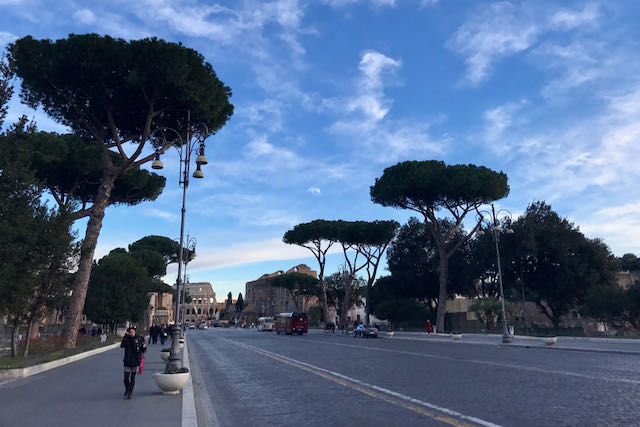 The via dei Fori Imperiali is one of my favorite streets to visit in Rome, and it's very wheelchair friendly due to the smooth surfaces, lack of (much) traffic, and extra wide sidewalks.
The via dei Fori Imperiali is one of my favorite streets to visit in Rome, and it's very wheelchair friendly due to the smooth surfaces, lack of (much) traffic, and extra wide sidewalks.These all have relatively smooth pavements, sidewalks and/or streets.
Riding the Metro in Rome in a Wheelchair
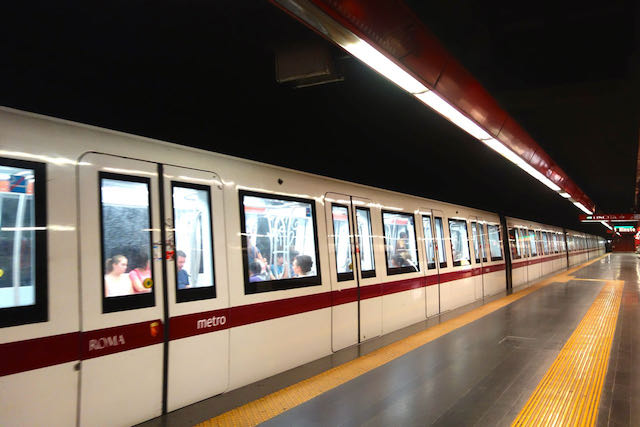 Rome's metro system has several locations around Rome with elevators/lifts and access for the disabled.
Rome's metro system has several locations around Rome with elevators/lifts and access for the disabled.To find out which Rome metro stops have facilities for the disabled, visit this page published by the city of Rome.
Getting around Rome by Bus in a wheelchair
The Rome public transportation system does not yet have this info in English.
But I can tell you that the following lines have facilities for the disabled:
H, 81, 85, 90, 170, 490, 44, 46, 60, 360, 80, 590, 87, 660, 671, 664, 558, 650, 20, 786, 781, 990.
The hop-on hop-off buses are another way to get around Rome, and most are wheelchair accessible.
Getting around Rome by taxi in a wheelchair
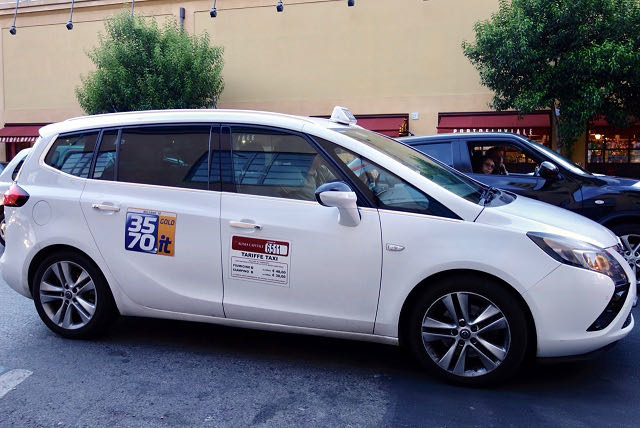 Among 7800 licensed taxis in Rome ( source updated on 31-12-2020 ) only 0.5% of them are available to users in wheelchairs. It’s not always easy to arrange for a taxi with facilities for disabled
Among 7800 licensed taxis in Rome ( source updated on 31-12-2020 ) only 0.5% of them are available to users in wheelchairs. It’s not always easy to arrange for a taxi with facilities for disabledThere are several taxi cooperatives that you can call.
The biggest one, 06 3570, has a large fleet of cars and vans outfitted for people with disabilities.
You can visit their site here.
I also read on this website that she used regular taxis, and simply folded up the wheelchair and placed it in the trunk.
She said all the cab drivers she dealt with were very friendly and accommodating.
Hiring a private service for transport in Rome in a wheelchair
All of the accessible Rome tour sites I linked to above also offer transportation in vans equipped specifically for people in wheelchairs.
You can contact this one for more information.
Travelling by train in Italy in a wheelchair
According to Italy's state-run rail company, Ferrovie dello State (FS), also often known as Trenitalia, "100% of Freccia trains have equipped areas for transporting people with reduced mobility or wheelchairs."
Their other train types also offer options for people with limited mobility.
Visit the Ferrovie dello State page all about accessibility for more details.
Besides the trains themselves, a reader let me know how much she appreciated the official FS services of the "Sala Blu."
Their staff work in the stations as a kind of go-between, helping passengers with almost any kind of disability move about the station and reach their train or next point of transportation if leaving the station.
Visit their website to learn more.
Some Excellent Resources - with my thanks
While researching what to write for this page about Accessible Rome, I came across some fantastic resources, some of which I refer to on this page.
These sites were written by people who have a lot of experience travelling with a wheelchair themselves, so I humbly defer to their expertise.
Two of the best sites you can refer to are wheelchairtraveling.com and sagetraveling.com.
Also, while writing and researching this page over several months, some of my readers have also chimed in.
If you have any suggestions for me to add to this page about Accessible Rome, or to change something you see that may be incorrect or incomplete, I welcome your input.
I am grateful for the advice of everyone who helped me put this page about Accessible Rome together.
Romewise's Top Travel Resources
Ready to book your trip to Rome? Take a look at these helpful links to companies we use and trust:
- Keep your travel spending simple with the Wise card, which removes all the worry about exchange rates and high transaction fees all over the world
- Search for and book your perfect accommodation
- Our complete guide to what to pack for Rome
- The number one travel accessory, a multi-point travel adapter and voltage converter
- Browse a huge range of tours in Rome and beyond
- Experience unique tours and special access to Rome's most popular sights
- Protect yourself with comprehensive travel insurance
Within this post there are some affiliate links for products and services. For more details about our affiliate policy click here.
Get your 100% free Rome trip planner now!
Simply sign-up today for our free newsletter and get the Romewise Quick Start guide to Rome:
We are committed to respecting your data. Click for our Privacy Policy.
Comments? Questions? Suggestions?
Please come over to the private Romewise Facebook group and join in the conversation.
You will often find me there, happy to answer your questions / comments!
You will also meet other Rome lovers and experts, too.
What are you waiting for?
- Romewise Home Page
- What to Do in Rome
- Accessible Rome

